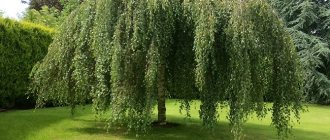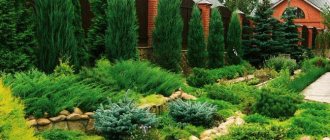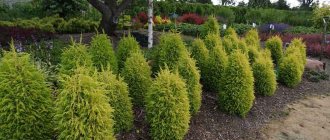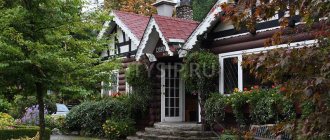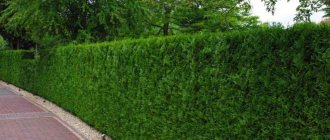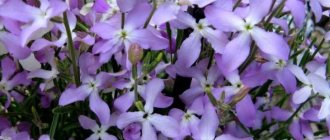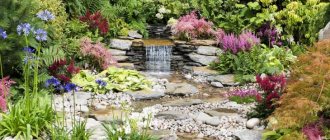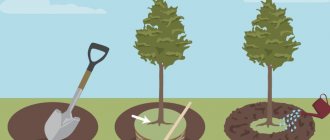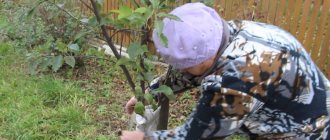A hedge can become not only a decorative element of decor, but also bring great benefits to property owners. Firstly, they shelter your garden from the curious glances of passers-by and attacks from uninvited animals, secondly, they protect the territory from strong winds and pollution, and thirdly, they can advantageously zone the space. Many people mistakenly believe that hedges require a lot of space, time and money. Currently, the market offers gardeners a huge variety and species of plants that will suit any needs.
Before choosing trees or unpretentious shrubs for a hedge, you need to decide on its functionality and size. For example, majestic thuja walls are often planted along tall buildings and fences. They help protect the area from neighbors and passers-by. But small hedges from the same cotoneaster can advantageously delimit the garden into small areas. If your site is a favorite place for wild animals, you can plant rows of rose hips with sharp thorns, which will create an impenetrable barrier and protect your crop from uninvited guests.
Types of hedges
Once you have figured out the functionality, you can start designing. At this stage you need to choose the type of hedge. They are conventionally divided into single-row, double- and triple-row. If with the first type everything is quite clear: it consists of single-species plants planted in an even row, then with the others gardeners have slight difficulties.
Double-row hedges are composed according to the principle: in the background there is a homogeneous background of single-variety plants, and in the front there are medium-sized plants, which are favorably set off against the green background by flowers or even berries, or unusual colorful foliage. Three-row ones are also classified according to height: tall, medium-tall and short-tall. Such hedges are voluminous and textured, effectively hiding unsightly walls or fences from view.
Single row hedge
A single-row hedge in a country house can consist of both coniferous plants and deciduous trees. The most popular conifers for creating living walls are the varieties of western thuja: Smaragd and Brabant. A hedge made of thuja decorates the landscape all year round, without requiring additional labor from the owners. If you have chosen thuja, we recommend that you familiarize yourself with the assortment, because there are a huge variety of varieties on the market: yellow dwarfs, spherical shapes, elongated and flattened ones - your eyes run wild!
Barberry is considered an equally popular deciduous representative in hedges. Variegated foliage, unusual shape, dense crown, as well as adaptability to growing conditions make it very popular among landscape designers. For example, Thunberg barberry has very decorative red shoots that look impressive against the background of snow or greenery, and also surprises with the colors of its small but numerous leaves.
Another bright representative of deciduous trees that will form an original living wall is the euonymus. Variegated foliage: from white to purple is simply mesmerizing to look at. Shrubs look no less decorative after the leaves fall, since during this period rosy, attractive berries ripen, decorating the landscape almost all winter.
Privet is an alternative option for creating hedges, but is not highly winter-hardy, so when grown in central Russia it requires shelter for the winter. The advantages of the shrub are its spectacular glossy green leaves, which acquire yellowish-orange shades by autumn. Also, by autumn, black, plump berries ripen on the bush, which add contrast to the foliage, but they are poisonous and unsuitable for food. Privet lends itself well to shaping and cutting, so hedges of unusual shapes are often made from it.
An equally striking representative of deciduous shrubs, ideal for zoning space, is cotoneaster. It is famous for its dense green foliage, which turns purple in autumn. Like privet, by autumn it bears decorative fruits that add a “zest” to the overall appearance. A hedge with berries not only looks impressive, but can also be useful in everyday life. From many fruits, including cotoneaster, you can make decoctions and liqueurs, add to teas and even make jam.
Hawthorn is an excellent option for those who are looking for unusual and unpretentious plants for a hedge. Hawthorn attracts attention all season long: in summer and spring it will delight its owners with delicious berries, which, as they ripen, change their color from yellow to rich red. In autumn, hawthorn surprises with its bright colorful foliage. For those who dream of creating an impenetrable wall for their garden, we recommend taking a closer look at the “cockspur” hawthorn. Its massive needles will become a natural barrier against uninvited wild animals.
For those who love paint and bright colors, an unusual ornamental shrub - forsythia - is suitable for creating a hedge. While all the plants are still waking up and recovering from hibernation, forsythia is abundantly covered with golden flowers that decorate the landscape for more than 20 days. If you plant seedlings in a row, you will achieve a smooth decorative wall of emerald color.
Fruit bushes
In addition to barberry, there are a number of other popular fruit bushes for sun and shade that do not require special care.
One of the common types is red currant, whose berries on the bush are pleasing to the eye. In addition to red currants, black currants are also grown at dachas near fences in the shade in the neighborhood. Its berries grow in clusters, like the red one. Currant bushes along the fence need to be watered frequently.
Red Ribes
Blackberries and red raspberries can be planted along paths in the shade where there is a border. Fruit bushes look great on large private plots, but if there is little space, then you should not plant them. The blackberries are trimmed because the branches of the bush should not touch the ground.
Raspberries
Viburnum bushes can also be planted near a private fence in the shade, but they need to be watered abundantly. Like blackberries, the viburnum bush is pruned to form a decorative crown and grow shoots of the plant.
Kalina
Multi-row hedges
We have presented several plants that will look great in single-row living walls.
All of them are considered suitable for growing in the Moscow region and tolerate shearing well, surprising with their unusual characteristics. Single-row hedges will be an excellent option for gardeners who have a small area on their property and want to enhance the landscape as much as possible. If you have enough space for planting, we recommend taking a closer look at other types of living walls: two-row and three-row. If you choose the right plants in height and shape, you can achieve continuous decorativeness of the hedge, as well as achieve maximum protection of the area from strong winds. As we figured out earlier, the principle of a two-row and three-row hedge is multi-tiered. Tall representatives are framed by medium-sized and low-growing shrubs. Various trees, such as poplar, willow, elm, rowan and others, are perfect for the background of such a design. You can also consider shrubs growing up to 3 meters. These are various bright representatives with decorative qualities: derain, sea buckthorn, serviceberry, mock orange or even lilac.
If you plan to use a hedge to zone your area, take a closer look at smaller trees and shrubs: the already familiar cotoneaster, the delicate and neat spirea, will become a beautiful addition to the hedge. Also, for medium-sized living fences, you can plant fruit bushes: currants or honeysuckle, for example. It is not only very beautiful, but also useful!
What to consider when disembarking
Before you go shopping for seedlings, think about the following points:
- is your side shady or sunny?
- how much wind blows the area;
- what is the purpose of planting: protection, decoration or shade formation;
- estimated area of landscaping;
- specifics of the dacha layout;
- what is the design of the fence (color, material);
- required planting height;
- depth of groundwater;
- soil type and composition, climatic features of the area;
- type of seedlings (requiring care or unpretentious);
- compatibility of different cultures;
- how long will the selected seedling grow to the desired size.
It should be taken into account that neat flowers and shrubs are planted in a small area, and massive trees are planted in large areas.
If the size allows, then planting is carried out in several ranks. Thus, a solid green wall is formed.
Low plants (for example, blue spruce) are recommended to be located closer to the road so that they absorb harmful exhaust gases from car fuel.
Large trees (birch, willow) are grown near the fence, the height of which exceeds the fence. This double wall protects private sector residents well from road dust.
We must not forget about the rapidly developing root system, which can damage the base of the fence, so the distance from the seedlings to the fence should be from 3 to 5 m. With a smaller value, the roots, as they grow, will lead to cracks in the foundation or a nearby fence will shade the trees.
Formed and mixed hedges
We have given the names of shrubs for hedges, which are excellent for unpretentious hedges that grow completely freely without much labor. If you have enough time and a desire to pay attention to plants, you can use plants to form hedges of various shapes. Clipped plantings look more original, are neat, hold their shape for a long time and can become the embodiment of any fantasies. The main condition for formed living walls is to use plants that quickly recover after cutting and retain their shape.
If you have a fairly spacious area and are looking for something original, you can create combined hedges on your favorite site. They are made up of plants with different leaf colors or flowering and fruiting periods. When designing such a living wall, there are no limits to the imagination: it can be different types of trees. For example, thuja alternates with spruce or pine. They can even be of different heights: then a low-growing shrub will cover the bare branches at the base of tall representatives. Various varieties of lilac look very good in mixed plantings next to tall mock orange, viburnum or forsythia.
What to plant along the fence if it is in the shade?
When choosing seedlings for planting near the fence, consider the plants' preferences for light and shade. It is better to place flowers with delicate leaves, as well as shade-loving crops, in the shade of the fence.
Coniferous trees can be planted in the shade: yew and fir. These plants are tall, but can be easily trimmed to adjust the crown shape and height after planting and decorate the area.
Yew
Hydrangea and elderberry seedlings in a flower garden, if planted in the shade, do not require loosening. Therefore, you can plant them in the far corners of the site near the fence.
Elder
You can also plant seedlings with red rowan berries and lilac bushes in a flower garden in the shade near a private fence.
Rowan
It’s clear what trees and bushes to plant in the flower garden near the fence. All that remains is to decide on the plants. Proper planting and care in the future will allow you to decorate the fence with the help of different plants and make the site attractive in any season.
Flowering plants for hedges
Before that, we looked at the most popular shrubs and trees that are ideal for creating hedges. Their main advantage is the decorativeness of their foliage. For those who prefer brightness and contrast, hedges that are strewn with luxurious flowers throughout the season are suitable. Such living walls not only attract the attention of any passerby, but also fill the space around them with a delightful aroma.
The popular hydrangea is often chosen to form a flowering hedge. Huge inflorescences, continuous flowering for months and ease of care - no one will pass by a hydrangea hedge.
Japanese spirea is a medium-sized shrub that blooms throughout the season. Spiraea planted in a row looks very gentle and neat. Flowers can be white, soft pink and bright crimson. If you have chosen spirea to create a hedge in your garden, we recommend taking a closer look at the original varieties “Little Princess” with pink inflorescences and “Anthony Waterer” with gorgeous crimson flowers.
Fragrant mock orange is an alternative option for creating a fragrant, flower-strewn wall. People often call it “jasmine”, as it has an incredibly pleasant scent and white, jasmine-like flowers. Mock orange is unpretentious, adapts well to new growing conditions and does not require much attention in care.
It is impossible not to mention in this list a less popular, but no less magnificent deutia - a beautiful deciduous shrub. It has rough green leaves of an unusual shape. In summer, the shrub is decorated with long, double, white inflorescences that fall to the ground under their weight.
Tall flowers
When placing bushes and trees, do not forget about flowers along the paths. A flower bed next to a corrugated fence will decorate it and give it a decorative look. It is better to give preference to tall types of different colors for such a flower bed, as they look more harmonious.
When placing different tall plants along the paths, pay attention to the sunflower, which grows in height. The plant is suitable for private houses and fences decorated in a rustic style. Sunflowers do not like shade and are best planted in an open area.
You can also plant tall rose bushes and gladioli near the fence in a flower garden in the shade. They are popular because they tolerate shade well. And bright red, white, yellow and other colors of flowers will delight the eye all summer in the flower garden near the fence.
Stock rose
A hedge of climbing plants
Just imagine: Your garden is surrounded by magnificent emerald carpets of plants crawling along the fence, with beautiful leaves and incredible flowering. Climbing plants have long occupied a special place in the hearts of gardeners and there are many reasons for this. Firstly, they grow faster than other plants, delight the eye with luxurious flowers abundantly and for a long time, and also do not require much effort and attention to care. A hedge made of climbing plants looks natural and original at the same time. To create emerald walls, you can choose both annual and perennial vines. But the latter are the most popular among gardeners, as they do not require annual planting. Perennial hedges will delight you with their decorative properties for many years.
The most popular climbing plant is the climbing rose. There are many varieties on the market that differ primarily in the color and shape of the buds: white terry, pink, yellow, red and many others - every gardener will find something to their liking.
There is no gardener who would remain indifferent to clematis. It is a climbing plant with amazing flowering. Flowers of unusual shape, very bright and showy. The most popular clematis has purple flowers, but there are varieties on the market with red, white, and orange colors.
Maiden grape is an ideal plant for use in a hedge. It does not require special attention, growing well in any conditions. It has decorative green foliage that turns purple in autumn. After summer, dark blue fruits ripen on the virgin grapes, but unlike ordinary grapes, they are not used for food.
Brown's honeysuckle "Dropmore Scarlet" is another bright representative of vines that can create decorative, very beautiful hedges in your garden.
From June to September it decorates the landscape with orange flowers of unusual shape, and from September red-orange berries appear against the background of green, lush foliage. The plant is unpretentious in care and has enviable winter hardiness. Hedges in the Moscow region are becoming more popular every year and this is not surprising: the variety of species and different varieties of plants, different shades of foliage, flowering and fragrant ones can create magnificent living fences, not only decorative, but also multifunctional. Which hedge will fit best into the landscape design of your country house is up to you to decide, because it depends on your preferences, the size of the plot, as well as possibilities. We hope that our article helped you understand a little about the variety of plants for hedges.
What trees to plant near different types of fences
In order to correctly determine which plants will be appropriate for a particular fence, it is worth taking into account the design features of the fence, namely the material from which it is built.
Wooden
For a natural hedge there are no restrictions in the choice of plantings. Against the background of a classic picket fence and boards, seedlings of fruit trees look good: apple trees, cherries, plums, pears.
Any shrubs (barberry, lilac, elderberry) will be an excellent addition to landscape design. You can experiment with wild grapes and hops.
Forged
Decorative forging goes well with conifers. They can make the boundaries of the site visually wider. Fans of original solutions should try to create a composition from various low-growing plants with exotic trees.
Photo: bushes hide the dacha plot from prying eyes
Chain-link mesh
Such a fence is installed in the private sector on the border of two plots or as a budget fence for a summer house. To reduce the number of curious glances at your estate, you need to build a green wall. Climbing plants go well with the mesh. Suitable:
You should be especially careful with the latter, since it grows quickly and is difficult to remove, so new shoots should be removed immediately.
It is recommended to plant plants at a distance of at least 1 m from each other.
If you want to use the soil near the fence to your advantage, we advise you to pay attention to the tall Jerusalem artichoke, which will become an excellent fruit shelter.
From corrugated sheets
This design has its own characteristics. The metal gets very hot in the summer under the scorching sun, which is why the choice of seedlings is quite limited. You should take unpretentious types (rose hips, raspberries, vines).
Photo: decorating the perimeter of the site with coniferous plants
Made of brick, concrete
For such a massive fence you will need good green camouflage.
The distance from the trees to the foundation of the fence must be at least 3 m. A smaller distance will lead to the destruction of the concrete base.
